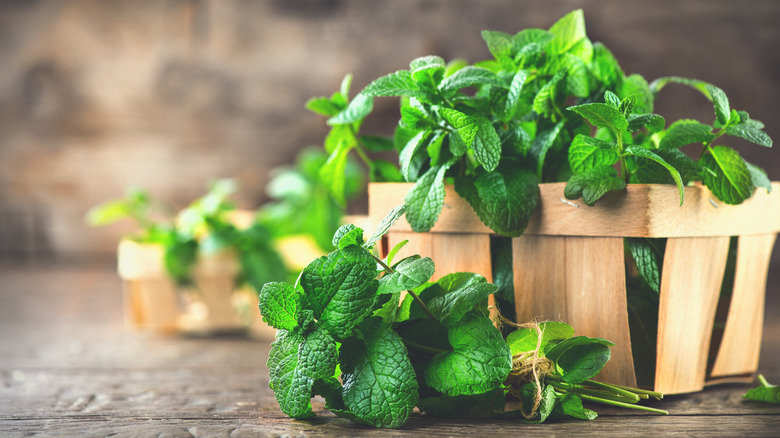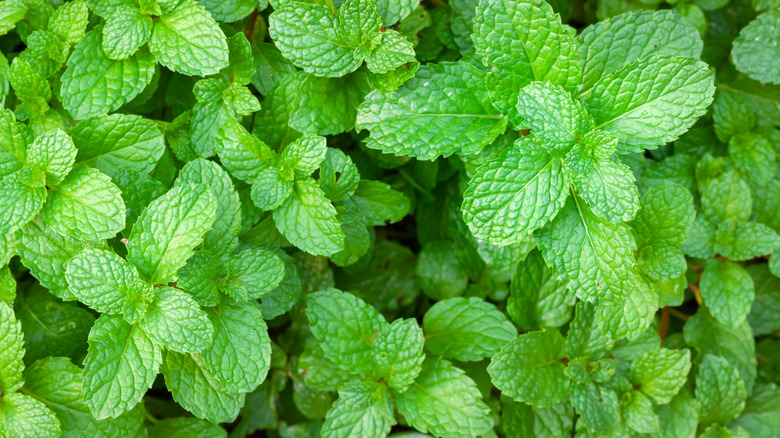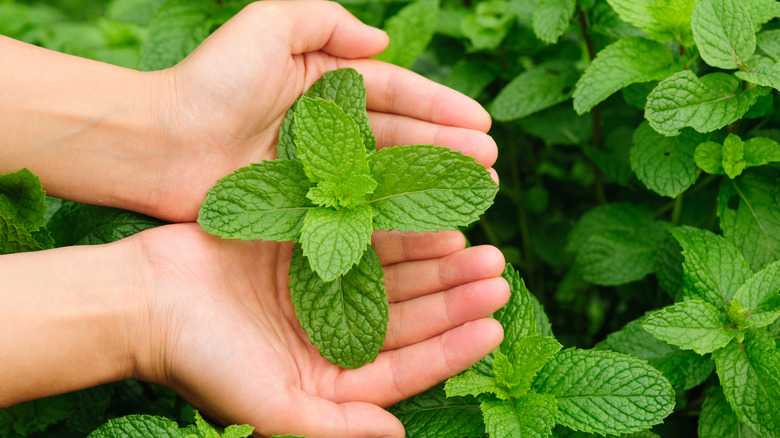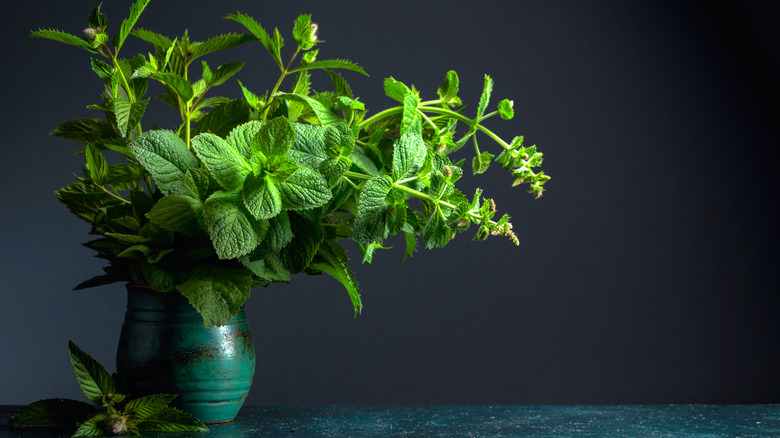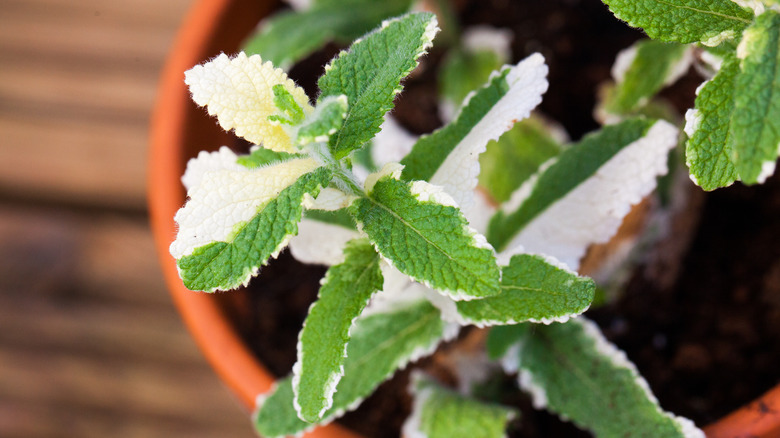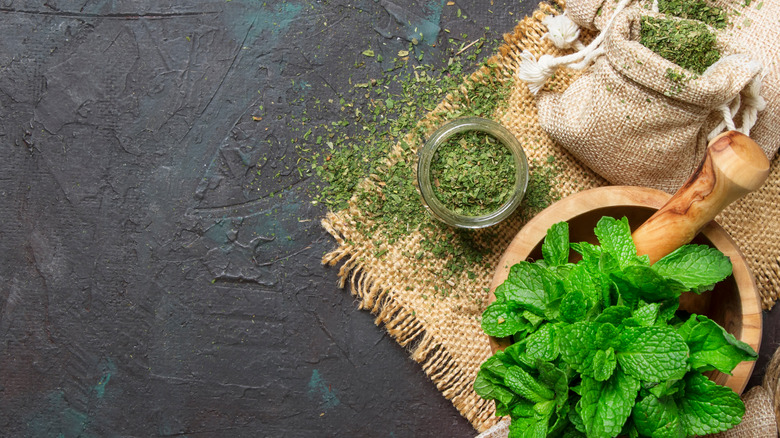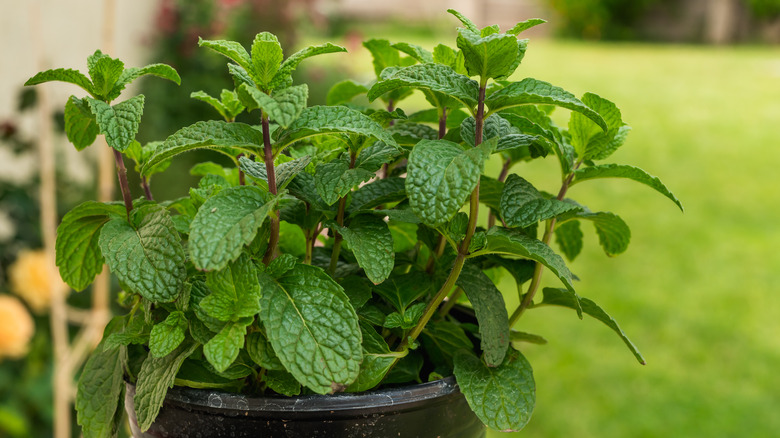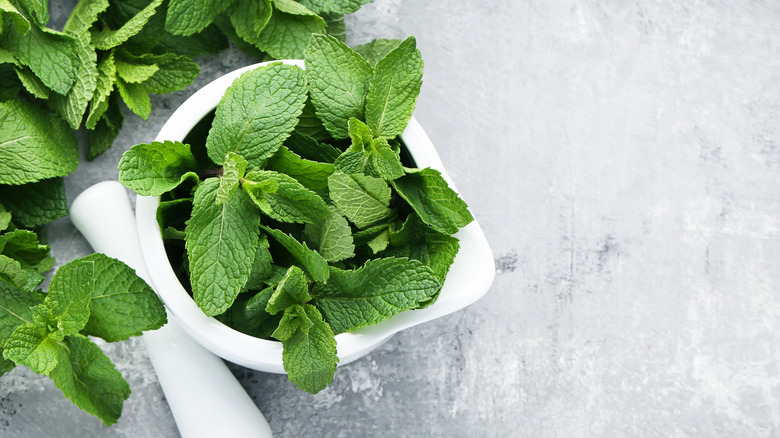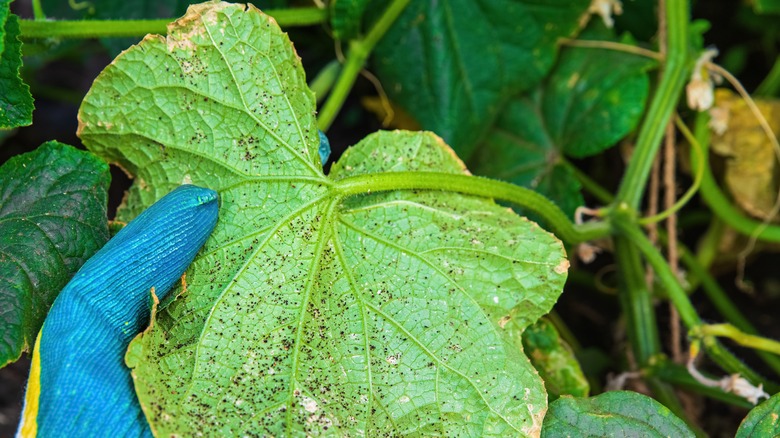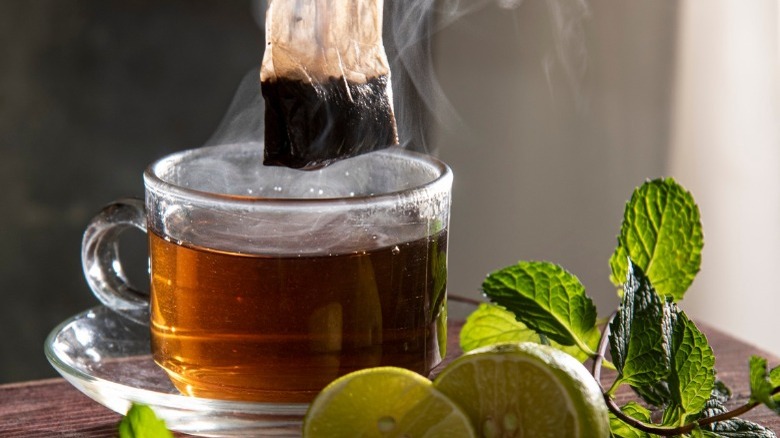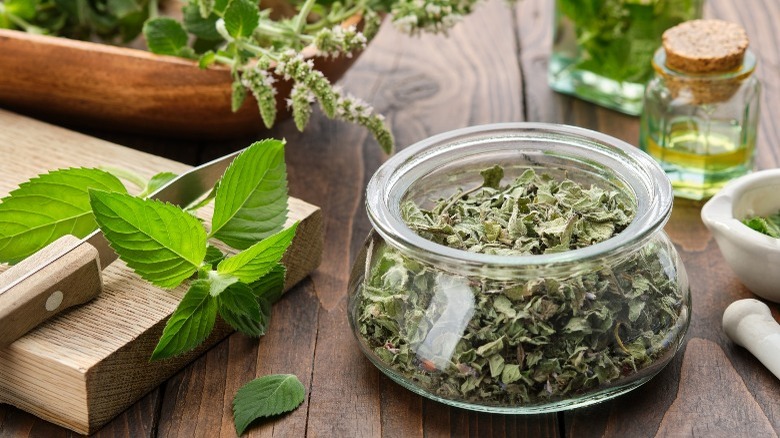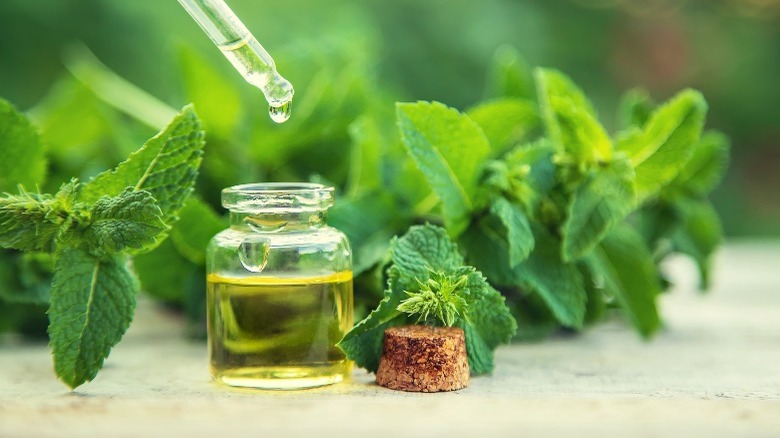How To Grow And Take Care Of Peppermint Plants
Peppermint, aka Mentha x piperita, is a herbaceous perennial plant that has been around for a long time. It is one of the oldest herbs used in medicinal and culinary practices. Because of peppermint's age, it was long thought to be a species all its own. Today, The Spruce explained, we know that it is actually a hybrid between spearmint and watermint. The plant originates from the Mediterranean region, but it is currently grown all over the world due to its great ability to adapt.
People can identify the peppermint plant by its dark green toothed leaves and reddish stems. During peppermint's flowering season, you will also notice its thick bundles of tiny light purple blooms. Gardeners around the globe grow peppermint throughout the year inside and outside of their homes. The plant is quite easy to grow and care for, making it an excellent plant for beginner gardeners. You'll be glad to have this plant around to use in your teas, desserts, or simply to give off a fresh scent in your home.
How to use peppermint in the garden
Most people choose to grow peppermint indoors for year-round use in their kitchen. But, the plant does great in the garden too. Before planting outdoors, you should keep in mind that peppermint spreads very quickly. Many opt to keep them in containers or in the garden with underground plastic barriers to prevent their roots from spreading, said Gardening Know How. If you want to grow your peppermint outdoors, you may consider planting it somewhere on its own in a small flower bed, a large pot, or in a raised bed.
Peppermint can be quite beautiful, especially when it flowers. Yet, don't plan on using it as a pretty border for your flowers, vegetables, or fruits. Due to its ability to spread, it will quickly take over your expertly placed garden plants. Without careful and constant watching, your garden bed will be riddled with peppermint. Because of this fact, some people choose to use peppermint as ground cover. You can even mow it!
How to grow peppermint
Peppermint plants don't need anything fancy to begin growing. All you need is a large pot, well-draining soil, and some time to regularly water it. They can grow in areas of full sun or full shade. But, you should know that peppermint plants that grow in darker areas tend to have less flavor.
People can choose to grow peppermint from seeds, or they can buy a young plant from their local nursery. According to The Spruce, gardeners can easily plant the seeds by pressing them into some prepared soil improved with compost and already moistened. It is unnecessary to bury the seeds. They will produce the best results if they are only partially covered by soil. While waiting for sprouts, keep the soil moist and warm if possible. In a little over a week, you will start to notice the peppermint's green heads sprouting up.
Instead of using seeds or pre-grown peppermint, some gardeners prefer propagating the plant. Though it can be done in a few ways, using stem cuttings is the most popular, explained Gardener's Path. To do this, start by cutting off a piece of stem that is 4 to 6 inches long. Then, from the lower half, pick off all the peppermint leaves and place your cutting into a glass of water. Plan to change the water every other day and keep it in a bright area. Your peppermint cutting should begin to grow its root system after nearly two weeks.
How to care for peppermint
Peppermint is very easy to care for once planted indoors or outdoors. These plants prefer partial shade with more than five hours of sunlight per day. Though, what makes them such a great plant for beginners, is that they will survive in almost any amount of sun as long as their soil stays moist. On that note, peppermint plants need quite a bit of water. Gardening Know How said it's okay to let the top inch of soil dry out between waterings but no more. Be careful not to let water pool in the bottom of the peppermint pot. This can lead to soggy roots that will quickly kill the plant. Always plant peppermint in a container with a draining hole to allow excess water to escape.
As with most herbs, peppermint does not require any fertilizer. According to The Spruce, we should avoid it. Fertilizer encourages plants to grow faster than normal. When you fertilize herbs like peppermint, this causes them to grow long and mostly leafless stems that do no good. If you want rich foliage with larger flowers, keep fertilizer far away from this herb.
Peppermint varieties
In the Mentha genus, there are hundreds of different species, hybrids, and varieties. Some of the most popular are spearmint, pennyroyal, apple mint, and peppermint, of course. Nearly all species of the Mentha genus are found today in North America. According to Gardener's Path, even within the species Mentha x piperita, several varieties feature their own looks, scents, and flavors. Here are five of the most popular peppermint varieties.
-
Mentha × piperita 'candymint' or 'candy peppermint' is smaller than your average peppermint plant. It is known for its intense taste and smell.
-
Mentha × piperita 'chocolate mint' is often used in desserts. Its name indicates a chocolate flavor, but it actually refers to its smell.
-
Mentha × piperita 'lavendula' or 'lavender mint' features tiny purple flowers and leaves that smell more floral than its cousins. It is often used for teas and potpourris as well as in cosmetic products.
-
Mentha × piperita 'lime mint' has brownish-green leaves that smell like lime instead of mint. Many use it to garnish summer salads or drinks due to its fruity taste.
-
Mentha × piperita 'variegata' or 'variegated peppermint' smells identical to peppermint, but it features creamy leaf edges. It should be kept out of direct sunlight to prevent scorching its leaves.
Is peppermint toxic?
Peppermint is toxic to dogs, cats, and horses. As it happens, nearly all species within the mentha genus are toxic. The oils that peppermint plants create are the real culprit. Peppermint oil can cause vomiting and diarrhea for these animals when ingested in large amounts, according to the ASPCA. If you suspect that your pet has ingested peppermint, you should immediately call your nearest veterinary hospital.
Interestingly, for humans, peppermint isn't toxic at all. In fact, it can be used in many meals, drinks, and desserts as well as for some possible health benefits. Peppermint tea has been scientifically proven to help with digestion, headaches, menstrual cramps, and stuffy noses, as explained by Healthline. Peppermint tea is simple to make and could be a delicious start to your mornings. Alternatively, you can use the peppermint you harvest to compliment your favorite fish, or you could add it to your morning mocha. It's amazing how versatile this herb is!
How to repot peppermint
When we grow peppermint, most of the time, it is grown in a container or a pot. Because of this and its ability to spread like crazy, the plant often needs repotting. Lucky for us, the process is fairly simple. Start by choosing your peppermint's new home. This pot should be larger in diameter compared to the last and feature an adequate draining hole, according to The Spruce. When using new soil, added fertilizer may cause the plant to become leggy. To combat this, you can trim your peppermint regularly to force it into a bushy and compact shape.
When a peppermint plant becomes too large for its container, some choose to divide it instead of transplanting it to a bigger pot. This is beneficial to overgrown plants because it keeps them healthy. If you are going to divide and repot your peppermint, plan to do it in the spring or summer, said Gardener's Path. To start, gently remove the entire plant from its pot. Gently tease excess soil from the roots to expose them. As you do this, the peppermint plant will likely split naturally. If not, you can carefully cut it into two sections with sterile scissors. Make sure both pieces have healthy growth beneath them. Place your two sections into individual pots with well-draining soil. Now you are the proud owner of two repotted peppermint plants.
The history of peppermint
Mentha x piperita or peppermint gets its name from Mintha in Latin. Mintha was a Greek nymph who was turned into a mint plant after angering Persephone, According to Gardener's Path. Piper translates to the word pepper which describes the spicy taste and smell of peppermint's leaves. For many years, the taste of peppermint leaves has been given to us through peppermint oil. This is made by distilling the plant and extracting its oils. Today, the oil from the peppermint plant is used to flavor several household items such as toothpaste, gum, mouthwash, and even some cosmetics.
In the U.S., Chowhound noted, nearly all our peppermint is grown and harvested in the Pacific Northwest. Years ago, Michigan held the highest amount of peppermint production, but it couldn't compete with the climate of Oregon, Washington, and Idaho. Peppermint loves its moist environment that allows for up to 14 hours of direct sunlight in the summer.
Peppermint pests and diseases
Aside from the fact that your peppermint plant might have taken over your garden, once you get it under control, you'll need to establish some precautions against pests and diseases. To be effective and better understand this, you need to know what they're susceptible to. As far as disease goes, PlantVillage tells us that peppermint plants are pretty hardy and resist much. They seem particularly vulnerable, however, to a fungus known as mint rust. It appears as small bumps on the bottom of the leaves, which can be bright orange, yellow or brown in color. Be sure to remove and isolate any plants or rhizomes you know or suspect have it, and heat-treat the roots for about 10 minutes in near-boiling water. Then immerse the roots under cool running water for about five minutes. After that, you're ready to replant.
Moving onto pests of the peppermint plant, we have a few common pests that we want to keep an eye on. It turns out that aphids, thrips, cutworms, and spider mites are all trying to consume the sweet, irresistible leaves of the peppermint plant. (Just your luck, right?) The list of living things that feed on other living things is essentially endless, and garden growers everywhere fight the perpetual battle of bugs every year. It will depend on which pest is pestering your plants to know what pest control measures to take, but there's one thing you can do to give yourself the best odds of winning your battle. Sprinkle some diatomaceous earth around the base of the plants. Taking this preventative measure can provide the barrier needed to prevent the bugs from getting to the plants in the first place.
What health benefits is peppermint used for?
Medical News Today reports that according to actual research, there are multiple health benefits from the peppermint plant we can take advantage of. Peppermint essential oil is often used in remedies, and you can make your own (see below), so why not? Some common ailments that peppermint helps with are indigestion, nausea, gas, and diarrhea. Peppermint is known for calming an upset stomach; it's also said to help ease muscle and nerve pain, as well as the pain of menstrual cramps. Furthermore, it's supposed to help ease symptoms of the common cold and lessen the anxiety caused by depression.
Another distinct characteristic of the peppermint plant is that you can use all the different parts of the plant for various health benefits. You can make peppermint tea or essential oil to use in your tinctures and recipes. You can even chew on the fresh leaves or toss some into a salad! You might find it interesting that peppermint is about 30% menthol and is considered a stimulant. Peppermint steam can be used for cold symptoms like respiratory distress and can help with mucus issues. It's important to remember that peppermint is an herb, which can interact with some medications. Some medicines it can interfere with are high blood pressure medicines, ulcer medicines, and acid reducers. Be sure if you plan to grow and use peppermint, you speak to your doctor first to make sure there are no potential issues.
How to make your own peppermint essential oil
If you're interested in growing peppermint and using it for its health benefits and herbal qualities, you'll want to know how to make your own essential oil. And, lucky for you, it couldn't be easier, according to the Los Angeles Times. Start with fresh peppermint leaves from your plants in your garden for the best results. Be sure to wash them thoroughly and dry them on paper towels before using them. You only have to decide which base oil, also called carrier oil, you want to use. Los Angeles Times suggests olive oil, grapeseed oil, or coconut oil; they all have unique added benefits. It depends on your personal preferences and what you plan to use it for. You'll also need a small jar with a secure lid.
Now that you have everything you need, it's time to start choosing the plants you will harvest leaves from. Start with a few handfuls of fresh leaves, and use a mortar and pestle, if you have one, to crush up the leaves and release the oils from within the plant. You can also do this with a knife, a large spoon, or even by hand. Once you have a decent pile together, stuff the leaves into the jar and pour enough of your carrier oil to cover the leaves completely, but no more. Then put the lid on the jar securely, and shake back and forth gently to combine well. Leave it in a dark, cool, dry place for two to three days, then strain the leaves out of the mixture and replace the oil in the jar. Now, repeat these steps at least two more times until you have the amount and strength you desire.
Where to purchase peppermint plants
Okay, so it's only natural to ask the question, where should I purchase peppermint plants? Nurseries are almost always our top recommendation. Peppermint plants are no exception. According to The Watershed Company, purchasing plants anywhere but at a nursery is a risk due primarily to care. Plants are so different, and while some are easy to grow with relatively low problems, others can be a nightmare. Do yourself a favor and spend the extra money to get a plant from your local nursery. Talk to the person running it, and ask them if they have any tips for you. Some of the best, truly helpful advice you can get on growing just about anything can be found at these small but successful nurseries.
Avoid any plants that have yellow or discolored leaves, as this can be a sign of a bigger problem. A plant from a good nursery will have a smaller chance of having any diseases or pests because it won't have been neglected for long periods. It's pretty easy to see what a healthy plant looks like compared to an unhealthy specimen. When you are serious about spending the time and effort necessary for a satisfying garden, this is the place to start.
